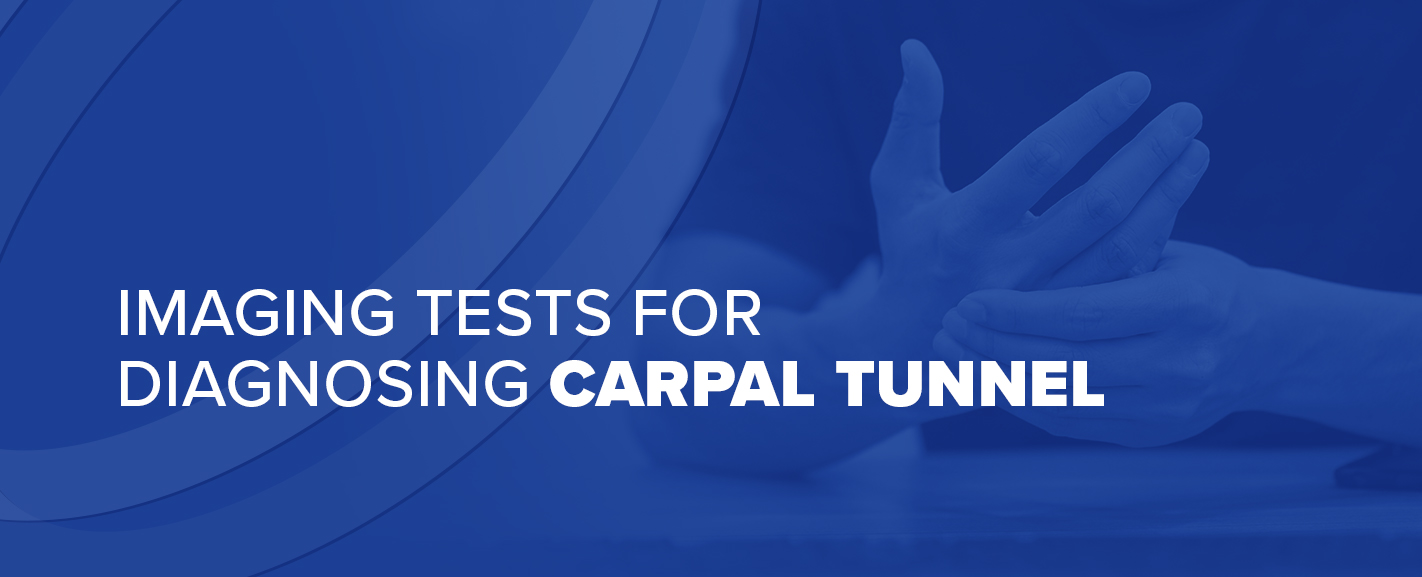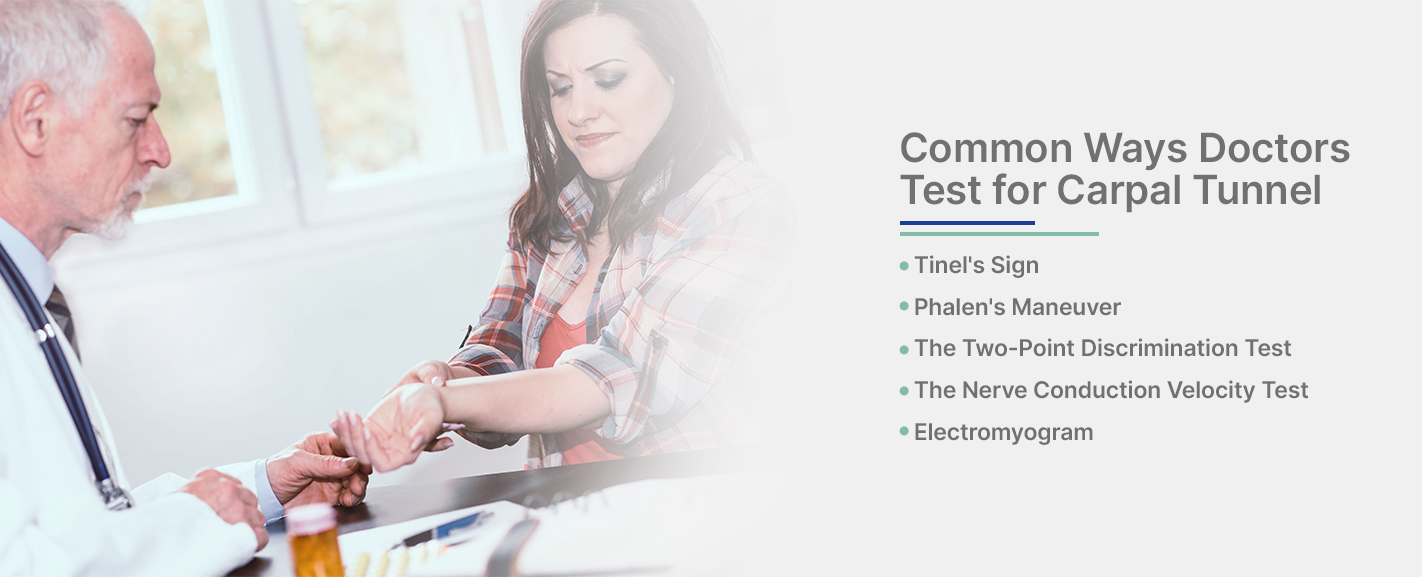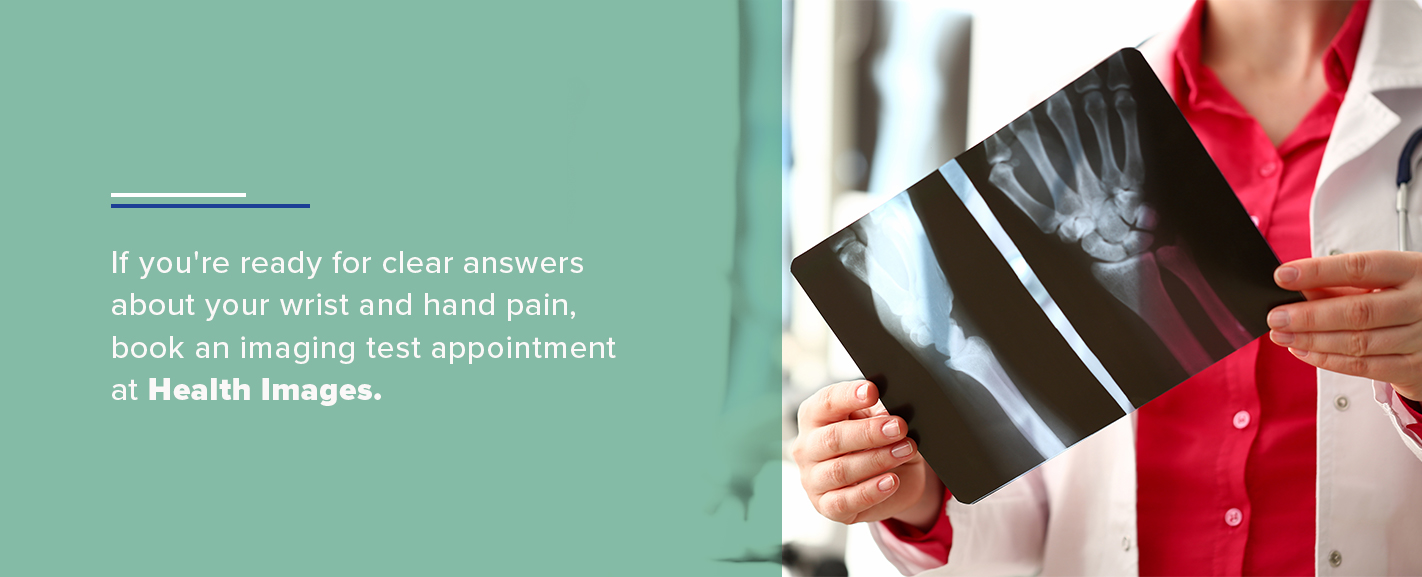Imaging Tests for Diagnosing Carpal Tunnel

Although carpal tunnel syndrome affects up to 6% of the adult population, there are still many questions surrounding the condition and its diagnosis. Many people with wrist pain wonder what causes carpal tunnel and what kind of tests can identify the issue. Fortunately, there are a variety of ways to figure out whether wrist and hand discomfort can be attributed to carpal tunnel.
We’ll cover what carpal tunnel syndrome is, common symptoms, how to test for carpal tunnel and carpal tunnel prevention tips. Getting a reliable carpal tunnel diagnosis is one of the best ways to stop the condition from worsening.
What Is Carpal Tunnel Syndrome
Carpal tunnel syndrome occurs from excessive pressure on the median nerve — the main nerve of the front forearm. The carpal tunnel itself is a narrow passageway surrounded by ligaments and bones on the palm side of the hand, which the median nerve travels through. When this area becomes inflamed from repetitive or strenuous hand motions and overuse, the median nerve gets compressed. This compression can cause a variety of symptoms.
Typically, carpal tunnel symptoms are mild to start and gradually grow more intense — especially if left undiagnosed. The following are the most common carpal tunnel syndrome signs and symptoms:
- Tingling: An odd tingling sensation in the fingers or hand is one of the earliest signs of carpal tunnel. Usually, the tingling affects the index, middle, ring fingers or thumb, but not the little finger. In more severe cases of carpal tunnel, the sensation in these fingers may feel similar to an electric shock. More progressive cases may also experience tingling farther up the wrist and into the arm, not just the fingers.
- Numbness: Along with tingling, the fingers or hand may feel completely numb at times. Oftentimes, the numbness will set in while holding an object like a phone, newspaper or steering wheel. Over time, the numbness may become constant.
- Weakness: The numbness in the fingers or hand may lead to weakness and dropping objects when trying to pick them up. Because the thumb’s pinching muscles are directly connected to the median nerve, carpal tunnel syndrome may cause weakness in a large part of the hand.
Common Ways Doctors Test for Carpal Tunnel
If you begin to experience carpal tunnel symptoms that interrupt your normal sleeping pattern and daily activities, it may be time to consult with a medical professional. Because carpal tunnel can result in permanent nerve and muscle damage when left untreated, It is important to diagnose the syndrome as early as possible.
When you see a doctor, there are several carpal tunnel tests they may conduct. Here are five of the most common methods for diagnosing carpal tunnel syndrome:
1. Tinel’s Sign
During this test, the doctor uses a reflex hammer to tap or press on the wrist’s median nerve. If the fingers tingle or experience a mild electric shock feeling, then the test is positive and the patient may have carpal tunnel syndrome.
2. Phalen’s Maneuver
Also referred to as the wrist-flexion test, Phalen’s maneuver involves the patient pressing the backs of their hands and fingers together with their wrists flexed and fingers pointed toward the ground. Once in this position, the patient will hold steady for a minute or two. If the fingers tingle or go numb during this time, the patient has carpal tunnel syndrome.
3. The Two-Point Discrimination Test
As its name suggests, the two-point discrimination test reveals if a patient can tell whether two objects touching their skin are two distinct points as opposed to just one. To conduct this test, a doctor may use a device known as a 2-point discriminator, which is a small, flat tool with eight sides and needle-like prongs protruding from each of them.
The test begins with two points touching the skin a few centimeters apart from each other before moving the points closer together until only one point of pressure is felt. This procedure may be done multiple times on each finger to get a more accurate diagnosis. The distance at which only a singular point of pressure can be felt will tell the doctor more about the patient’s nerve function and compression, which will help determine whether they have carpal tunnel.
4. The Nerve Conduction Velocity Test
The nerve conduction velocity test is one of the most dependable ways to diagnose carpal tunnel syndrome. By measuring how fast an electrical signal travels along the forearm’s nerve or from the nerve to a muscle, this test can produce reliable evidence of the syndrome.
To start the nerve conduction velocity test, the doctor will place a small electrode on the patient’s skin close to the elbow. The electrode will then send a mild electrical current down the patient’s median nerve. The longer it takes for the current to pass from the patient’s elbow to their fingers, the more damage their median nerve has sustained.
5. Electromyogram
Similar to the second portion of a nerve conduction velocity test, an electromyogram measures how well the muscle tissue surrounding the median nerve functions. The test involves placing a small needle electrode into the muscles that receive impulses from the median nerve, then sending an electrical impulse into the muscles. By observing the patient flex and relax their hand during the test, a doctor can determine whether the median nerve is damaged or getting compressed.
Diagnostic Imaging Tests for Carpal Tunnel
For a more reliable carpal tunnel diagnosis, a medical professional may call for an imaging test. By providing a clear picture of the forearm’s tissues and ligaments, an imaging test can help doctors determine the underlying cause of wrist and hand pain easily. These are the three main imaging tests for carpal tunnel syndrome:
- Ultrasound: A carpal tunnel ultrasound is often used to detect structural abnormalities, such as swelling or compression, in the median nerve and the soft tissues around it.
- MRI: Like an ultrasound, a carpal tunnel MRI provides a detailed look inside the body to reveal whether the median nerve is swollen or compressed, along with why the nerve is being squeezed.
- X-ray: Although an x-ray can’t show carpal tunnel, it can rule out other causes. If it is uncertain whether carpal tunnel syndrome is the root issue, an x-ray can help the doctor assess whether a bone fracture or arthritis is really to blame for the patient’s acute wrist pain.
Tips for Preventing Carpal Tunnel
Although carpal tunnel syndrome can be hard to prevent, there are some simple lifestyle changes that can decrease a person’s chances of developing the condition. Here are some of the most effective ways to avoid a carpal tunnel diagnosis:
- Workstation changes: Practicing proper seating, hand and wrist placement can save the medial nerve from unnecessary stress.
- Straightening the wrists: Sleeping with straight wrists as well as keeping the wrists straight when using tools can combat carpal tunnel.
- Resist repetitive motions: Refraining from flexing and extending the wrists repeatedly along with decreasing repetitive grasping motions can prevent the onset of carpal tunnel.
- Resting: Taking frequent breaks from activities that require repeated wrist flexion as well as adequately warming up before and after these activities will help avoid damaging the median nerve.
- Monitoring medical conditions: Properly treating conditions commonly associated with carpal tunnel, such as diabetes, can keep the chances of developing the syndrome low.
Schedule an Appointment for Your Imaging Test at Health Images
If you’re ready for clear answers about your wrist and hand pain, book an imaging test appointment at Health Images. Health Images offers immediate turnaround times so you can have high-quality, accurate results from your imaging test within hours of leaving the center. Along with fast results, we provide flexible and quick scheduling options to meet your needs.
For more information or to schedule your appointment, find the Health Images location nearest you today.
Sources
- https://www.aafp.org/afp/2011/0415/p952.html
- https://www.mayoclinic.org/diseases-conditions/carpal-tunnel-syndrome/symptoms-causes/syc-20355603
- https://www.sports-health.com/sports-injuries/hand-and-wrist-injuries/diagnosing-carpal-tunnel-syndrome





